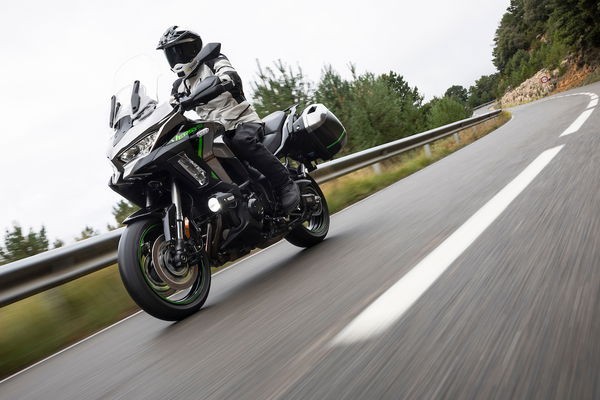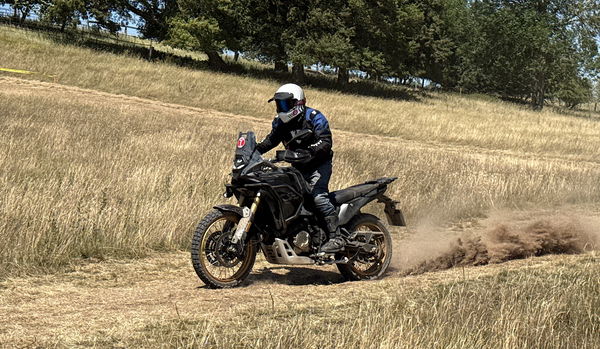2025 BMW R1300 GS Adventure Review
We’ve ridden the new GS Adventure on and off road, and found it to be very much worth its punchy price tag

“A fridge with a beak” is among the unflattering comments we’ve heard about the way the 2025 BMW R1300 GS Adventure looks. But really, none of the discourse matters. For one thing, the GSA has never been about looking attractive, and for another, it won’t stop BMW from selling them by the boatload. But is it any good?
Visordown contributor Adam ‘Chad’ Child rode the bike on and off road in Andalucia, Spain, while group editor Matt Robinson tried the bike at a UK ride event on a variety of roads in Wales, where amazingly, the sun was shining.
Here’s what we discovered.
R1300 GSA pricing and availability
The standard GSA comes in at £18,870, the TE version at £20,635, and the top-of-the-range TE ASA variant at £21,300. As is always the case with BMW models, there are plenty of individual options and packs to inflate these figures further. All versions of the GSA are available to order now and are already in BMW Motorrad UK dealerships.
How is the R1300 GSA different from the R1300 GS?
Technical review by Phil West
The GS Adventure is based on the new R1300 GS as launched for 2024 so is similarly powered by BMW’s all-new, 1300cc, 145bhp boxer twin with the same pressed steel ‘shell’ frame.
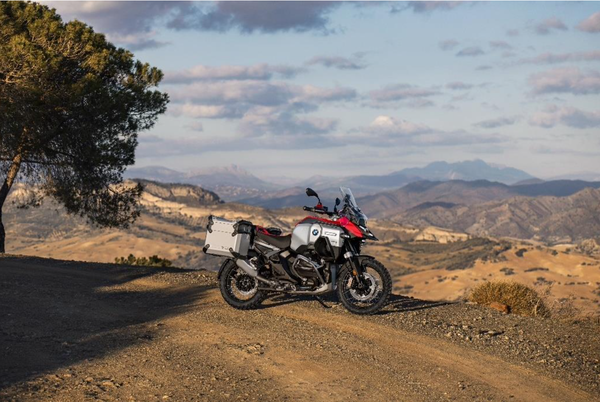
What sets the new GSA apart is its much bigger (and also much wider) 30-litre aluminium fuel tank (the standard GS’s holds 19 litres), so shaped to aid tank bag fitment; its strikingly angular revised styling (some have already likened it to Judge Dredd’s Lawmaster motorcycle from the eponymous 1995 movie starring Sylvester Stallone) which includes new clear side wind deflectors; and its now standard-fit, ally-rimmed, ‘Crosspoke’ wire wheels (the base, standard 1300 GS comes with cast alloy hoops).
As well as being wider, the new GSA is also taller with 20mm more suspension travel front and rear in keeping with its role as an adventure and expedition machine. As a result, spring travel is now 210mm at the front and 220mm at the rear.
The new GSA’s also the first BMW to come as standard with the marque’s new Automated Shift Assistant (ASA) with automated clutch operation. The system is now available on the R1300 GS.
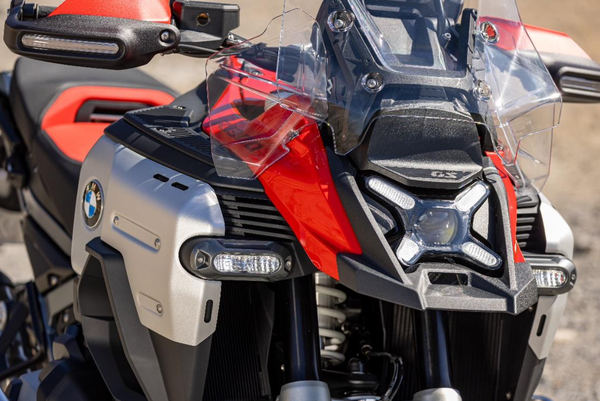
As with the standard 1300 GS, four different versions of the new GSA with varying spec and colour options will be made available: a basic variant; Triple Black; GS Trophy and the top spec Option 719 accessorised version, which is this time called the Karakorum as opposed to the R130 0GS Tramauntana.
Other features carried over from the 1300 GS include the new style ‘Matrix’ LED headlight (with adaptive lighting available as an optional extra); BMW’s Dynamic Cruise Control (DCC) with brake function; the German firm’s familiar, tried and tested 6.5in colour TFT dash with accompanying scrolling wheel switchgear; keyless ride, ‘Emergency Call’; heated grips; a smartphone charging compartment complete with integrated USB charging point and four riding modes as standard
Optional extras, meanwhile, include BMW’s new radar-guided Riding Assistant with Active Cruise Control (ACC), Front Collision Warning (FCW), Lane Change Warning and Rear End Collision Warning (RECW); a new, all-aluminium three-box luggage system comprising 37-litre top case and 37-litre (left) and 36.5-litre (right) panniers and BMW’s clever new Adaptive vehicle height control system which works with the marque’s latest Electronic Dynamic Suspension Adjustment (DSA) system.
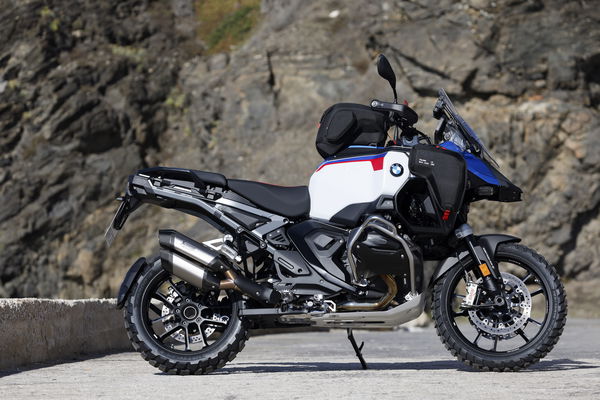
Claimed kerb weight of the new 1300 GSA is 269kg (compared to the 1300 GS’s 237kg), its seat height is 870mm adjustable to 890mm (GS: 850-870mm) but its availability is yet to be revealed.
What's it like to ride?
The big GS is intimidating. But isn’t it supposed to be? For the record, I’m not quite 5ft 7in tall, I spent the majority of the test on the Trophy with Enduro seat 895mm/915mm. However, tick the option box for the adaptive vehicle height control, and this automatically lowers the seat by another 30mm to 850mm on the standard bike when the bike comes to a halt. The optional lower seat drops the seat to 840-860mm, or 810-830mm with the adaptive vehicle height control. You can even go one stage further, with adaptive height control comfort, which dops the seat to the lowest option at 790mm-810mm.
So you can make the Adventure lower but you can't make it smaller. Throwing a leg over the full-height Trophy variant, complete with its tall Enduro seat 895mm, revealed a massive motorcycle, especially with useful radiator-cowl side bags fitted. With the bike upright, I’m on tiptoes, but just about secure enough to feel confident (895mm seat height Enduro). Alternatively, I can slide one leg across, get one foot securely down, and am still able to reach the back brake or gear selector with the opposite foot. Using the adaptive vehicle height control on the standard seat 870mm makes a difference: with it activated I can reach the ground securely with both feet, though I'm still not flat-footed – this on the standard seat but now lowered to 850mm.
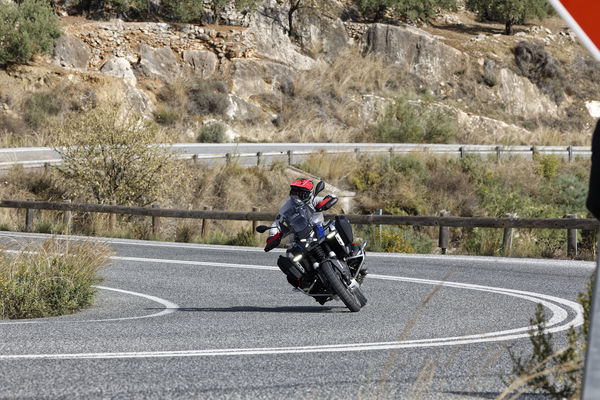
But, predictably, as soon as the wheels are turning, the daunting bulk of the Adventure becomes a distant memory. Like every GS boxer I have ridden previously, there is a lovely natural balance to the way it rolls. At slow speeds, even walking pace, it spoon feeds me confidence and makes me feel like a different person. The extra-wide fuel tank is a constant reminder that the Adventure weighs 269kg (before extras like luggage) yet at just 3mph it seems to weigh nothing at all.
As with the standard R1300 GS, the screen is electronically adjustable, and both cruise control and DSA Dynamic Suspension Adjustment come as standard – in fact there is no option for conventional, manually adjustable suspension on the Adventure. There are four standard riding modes and a large raft of rider aids. Then it’s just a question of how many boxes you ticked in the accessories pack.
You can, for example, opt for up to seven riding modes by adding Dynamic, Dynamic Pro and Enduro Pro to the standard Eco, Road, Enduro and Rain. Gearshift Assist Pro, which allows almost seamless up and down shifts, is an optional extra that I believe should be standard. You could opt for the very clever and easy-to-use Active Cruise Control (ACC), which incorporates Lane Change Warning and the Rear End Collision Warning (RECW). There are screen options, multiple luggage and top-case choices... The options seem endless. The configurator will make you giddy.
In no time, we hit Andalusia's dusty trails. Riding a giant adventure motorcycle off-road is no small feat, and the tank does cramp your stance a bit, but the bike’s suspension handles its bulk surprisingly well. The smooth boxer engine means it can crawl along dirt tracks as if it's in town. In Enduro mode, the bike’s fueling feels spot-on, making the GS less intimidating than it looks.
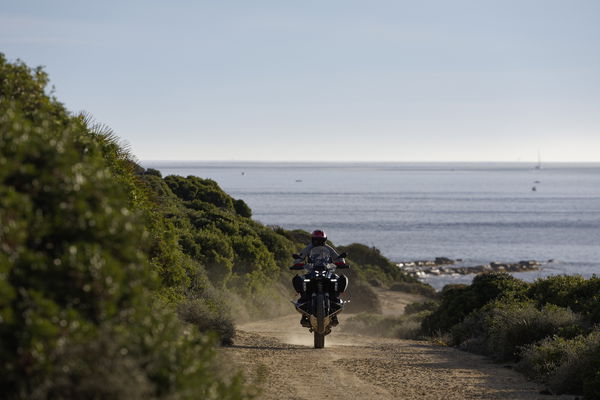
On wide trails, I was able to top 60mph with clear views ahead, kicking up satisfying dust curtains. In Enduro Pro mode, you can dial down the traction control (TC) or switch off the rear ABS, making the rear wheel feel like a playful toy. Give it some throttle, and the rear tyre spins but stays controlled. Lean or counter-steer, and you get a smooth, thrilling slide.
The TC gently keeps you in check, like an off-road pro on the backseat, letting you test your limits. Before long, you’re sliding around just to see how much you can get away with! The ABS brakes also find grip where you wouldn’t expect, making even 269kg of bike and rider stop smoothly on gravel.
Just remember: it's BMW’s tech, not your skill, that’s pulling off those slides. Turn off TC, and it can feel like a 140bhp pendulum. After a day of dust and power slides, my aching arms reminded me just how heavy this beast is. Still, I loved every second of it.
Sure, lightweight enduro riders may laugh at the GS’s boat-like feel, and pros might find the ABS a bit much. But for big adventure bike fans, it’s impressively capable. Plus, with the solid crash protection, a little tumble won’t hurt the bank balance... too much.
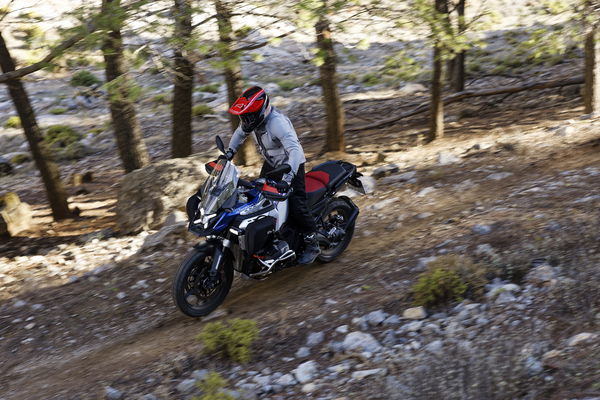
Back on the asphalt, the compliments keep on coming. In Road mode, the ride quality prioritises comfort over performance, via the Dynamic Suspension Adjustment (DSA). As it’s so comfortable and softly damped, it really shouldn’t handle as well as it does, but the DSA takes everything in its stride and makes the ride effortless.
When the pace hots up, you need to flick into the Dynamic or Dynamic Pro modes, which gives the Adventure more support and a tauter ride. There's noticeably less suspension travel and also more feel coming back from the tyres, meaning you can push on a little harder and enjoy the potential of the new Adventure.
The Karoo 4 rubber copes well on the road, but just when pegs start tickling asphalt, you have to remind yourself (again) that you’re on a 269 kg machine on heavily off-road biased rubber – and that the laws of physics can’t be broken. On occasion I could feel the tyres move on their tread blocks, and took it as a warning.
That I even tried to push the handing is a massive compliment to the Adventure's chassis and electronics. The feel transmitted via the DSA suspension is impressive, too, the limit clearly signalled, while the rider aids work quietly in the background. Just to see, I accelerated very hard out of slow corners with the bike banked over to try to provoke a slide. Each time the Dynamic Traction Control (DTC) calmly said no and kept the Adventure driving forward. The TC light illuminated on the dash and I could feel the power reduce – that safety net again expansive and reassuring below my trapeze.
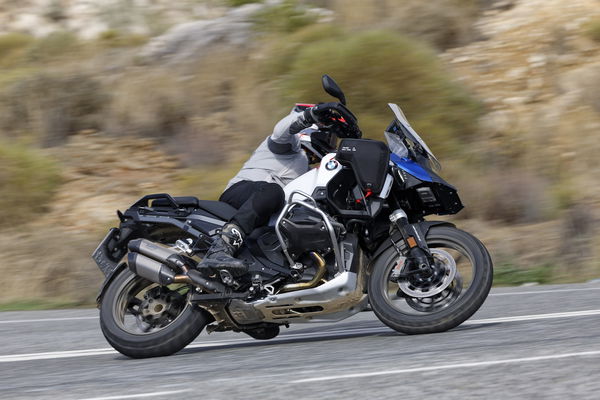
The essence of the Adventure is the way it has been designed to be friendly and easy-going despite its mighty size, although the amount of effort required to make quick direction changes through esses varies depending on which model you are riding, the accessories it has, and the amount of fuel onboard. When the fuel levels are at around 15 litres and below, the Adventure's road manners mirror those of the standard R1300 GS. But with a full tank of gas, you have to work harder. Hit a switchback section on a mountain road at speed, and you physically feel it. Sure, the Adventure can hustle and it is fun but it certainly requires more effort than the standard GS.
The radial stoppers are carried over from the standard GS and have cornering ABS as standard, recalibrated for the Adventure's different suspension and weight. The four-piston callipers are strong on the road –and you can feel the ABS working from time to time, especially the rear in Road mode – but not as sharp as those on the GS, which has less weight to deal with.
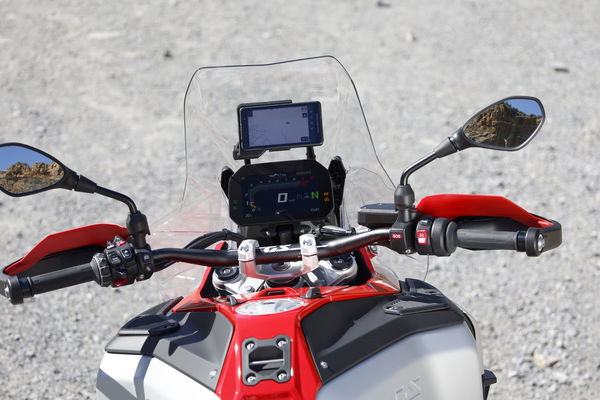
Like the brakes, boxer power is carried over from the R1300 GS. Over two days of riding I don’t think I ever got close to the redline; there’s simply no need given the twin's luxurious, deep-pile carpet of torque. Gear changes are infrequent, instead the Adventure flows across the planet , the revs embedded in one of the richest and most flexible of mid-ranges, even during a spirited ride.
If you want to cover hundreds of miles efficiently and in a blanket of irritation-free comfort, the R1300 GS Adventure might not just be the best adventure bike for the challenge, but the best bike, full stop. Comfort is relentlessly good, mile after painless mile, especially if you configure your machine with the larger screen, comfort seat and adaptive cruise control. Just sit back and wait for the fuel light to illuminate.
BMW quotes a massive 380-mile range at their claimed 57.6mpg – which is a long old stint between stops in anyone's book. On test, I averaged 5.7l/100km or just shy of 50mpg, which considering the abuse the Adventure it took off-road wasn’t bad at all. There were lots of off-road trails where I was using only second and third gear and spinning the rear for fun. Ridden properly, BMW’s claim of 57.6 mpg for the Adventure is well within reach. On occasion, the range readout was reading over 650km or over 400 miles, The screen on the photographed Trophy model was perhaps a fraction low and high mileage tourers should avoid the harder Enduro seat. But those details aside, this is the bike if you want to eat entire countries whole. The big Adventure is hungry for it.
How is it on UK roads?
While lacking the off-road elements, Visordown’s UK test of the bike is closely aligned with how most customers will use their GSAs most of the time - away from the rough stuff. That said, Britain’s road network isn’t what you’d call smooth, either, but similar to the GS, the suspension does a remarkable job of soaking up whatever’s thrown at it. You find yourself wincing in anticipation of a hard-to-avoid pothole causing the dampers to crash through much of their travel, only to find very little in the way of dynamic drama.
From behind the bars, the upsized fuel tank dominates the view in an imposing fashion, but the GSA rarely feels like a big, ungainly thing even when navigating twiddly Welsh mountain roads and occasionally braking for a wayward sheep. Slightly set up and unobtrusive electronics combined with those Karoo 4 tyres mean the GSA inspires confidence even on damp roads.
The boxer twin’s 140bhp and 104lb ft of torque feel perfectly matched for UK roads. It’s enough to make progress feel effortless, but not so much that an overly enthusiastic twist of the throttle punts you into legally troubling speeds.
Should you buy a BMW R1300 GS Adventure?
BMW nailed it with the R1300 GS Adventure. This isn't just a GS with a big fuel tank; it’s a beast with its own personality and serious curb appeal. And in person? It looks good.

BMW's quirky approach has paid off, with thoughtful design, practical features, and a staggering list of accessories that make it a standout in the market. Sure, it’s big and a bit intimidating, but for a bike that can devour tough terrain and cross countries, wouldn’t you expect some presence?
Despite its 269kg heft, it’s a champ both on and off-road, with excellent balance, smooth fueling, and a clever seat-lowering system to make it accessible to almost anyone. It’s comfortable for all-day rides, a blast on trails, and surprisingly manageable around town.
The hard part? Choosing a model and accessories: are you more of a long-haul tourer or an off-road enthusiast? The right boxes can make it feel like a custom fit. Really, the only limits are your budget—and your imagination.
